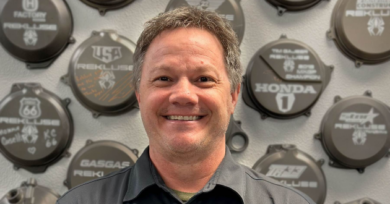An ambitious sales drive – January 22, 2007
Nobody can accuse the still relatively new Triumph Motorcycles (America) CEO of starting off with mild expectations.
Or even moderately difficult ones.
Mark Kennedy, six months into his new job with Triumph, recently delivered a staggeringly difficult five-year goal: to nearly triple the sales of the North American subsidiary of Triumph Motorcycles, Ltd.
“Possibly some people think I’m a little bit crazy,” the British native said in an interview with Powersports Business. While that comment is more a reflection of his sense of humor, Kennedy’s goal of reaching the previous Triumph record of U.S. sales for one year of 28,500 is no joke.
“If Triumph has done it once, there’s no reason why it can’t do it again,” he said. “I think five years getting to that point is a very achievable target. It is very aggressive, but I’m very confident that we can achieve it or get very close.”
What makes the target all the more difficult to achieve is the fact that Triumph (America) is coming off a wildly successful year where year-end sales are expected to be somewhere in the neighborhood of a 27-percent improvement over last year. But even with that improvement, Triumph (America) will have sold 10,726 new units. That’s a notable milestone considering it’s the first time the Hinckley, U.K.-based manufacturer has eclipsed 10,000 units in one year since Triumph’s return to the United States in 1995.
But it is still well short of Kennedy’s five-year goal.
What makes Kennedy, previously the company’s leader for its operations in France and Switzerland, think the company can achieve that rate of growth? He points to new product currently in the pipeline and a dealer network that he expects to grow in size and quality in the coming years as the primary reasons.
“Some of these high-profile dealers that are knocking on the door and the restructuring and the general growth of the dealer network can have a massive impact on Triumph,” he said.
Triumph (America) currently has about 175 dealers in the United States and 15 in Canada. He expects the U.S. dealer network to increase to 250 to 275 “depending on the market and how good are we at attracting the right dealers in the right place strategically,” Kennedy said.
“I’m a strong believer in not just adding dealers to add volume. What that does do is dilute the dealer sales that you’ve already achieved in some of these market areas.”
Triumph (America) reports its sales per dealer has nearly tripled in the past three years, rising to an average of 65 from 25.
“I think that’s a very good sign of our dealer development plans and what we’ve done,” Kennedy said. “We’ve actually trimmed a number of dealers out, but we’ve managed still to increase our volume. So I still want to do that.”
Kennedy said there are a number of strategic points in the United States that Triumph (America) is trying to fill. What the company looks for in a dealer has more to do with the dealership’s focus than product mix.
“I think the European brand (product mix) probably works nicer from an image point of view, but we also have some very successful Japanese Triumph dealers as well,” he said.
The dealer’s brand mix, however, is not “as important as making sure we’re No. 1 or No. 2 in that dealership in terms of focus,” Kennedy said.
Finding quality dealers to fill those strategic openings doesn’t concern Kennedy, a situation that is far different than the one he once encountered in the European market when industry sales there were down. When sales rebounded in Europe, Kennedy saw a turnaround in dealer interest. That same interest greeted him when he became CEO of Triumph (America) in April.
“It has been a pleasant surprise in my first six months of how many good quality dealers actually have been knocking on the door from some of the other brands,” he said. “So I’m very pleased about that.”
As Triumph (America) continues to build its dealer network in hopes of hitting that 28,500 target, one area that Kennedy says he won’t have to worry about is production. In its year-end financial report, the Triumph Group said it invested in new production capacity. Kennedy said the company added a third warehouse to its manufacturing facility in Thailand. That facility for the past couple of years has manufactured components for Triumph motorcycles. The additional capital investment allowed the company to begin building complete bikes there in 2006. However, most of the company’s motorcycle production remains at its U.K. plant.
With production taken care of, Triumph (America) will focus on dealer development and increasing its brand awareness. Triumph is currently working on a four-day open house scheduled for March that so far 106 of its dealers will attend. The open house will give dealers a chance to tout the company’s new product line, including the new 675 and the new Tiger 1050. Plus, Kennedy hinted at a third new model, possibly in the urban sport range, that the company might introduce this year.
“I personally, and the whole team here, are behind the fact that we would like to be the No. 1 European brand in terms of sale for the whole year, and not just the odd month,” Kennedy said. “I think we all need to focus on that.”




